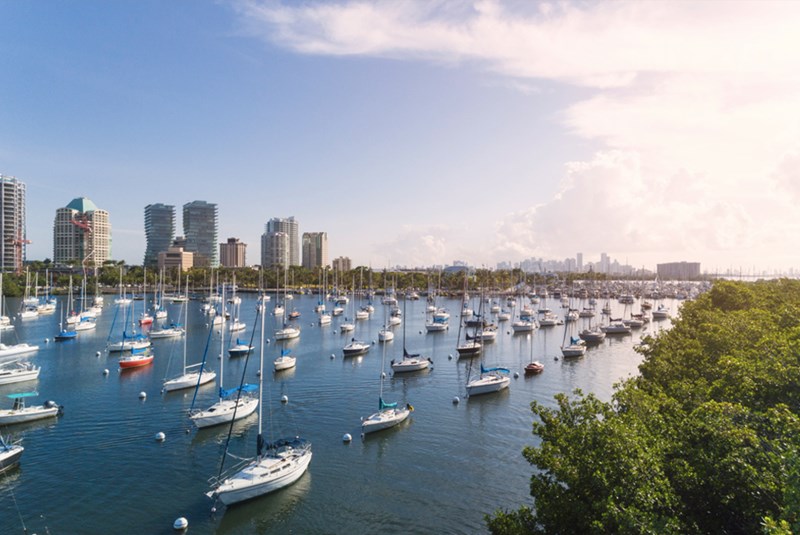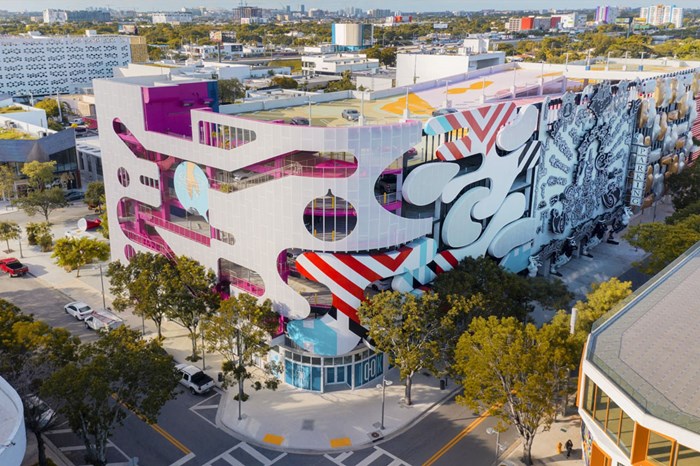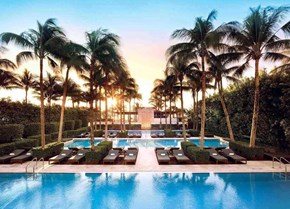Miami’s Most Iconic Buildings & Landmarks

Oct 28, 2022 October 28, 2022
Home to one of the biggest collections of Art Deco architecture in the U.S. and the world, Miami has always been an architectural showcase and a destination for some of the most iconic and beautiful buildings around the globe.
For lovers of architecture and design, as well as history, intrigue and nostalgia, here’s our list of 22 of Miami’s most iconic buildings and landmarks – both old and new – and what makes each one unique and special. If you haven’t visited all of these buildings, go check them out!
Iconic Buildings on Miami Beach
1111 Lincoln Road
1111 Lincoln Road, South Beach
Built in: 2017
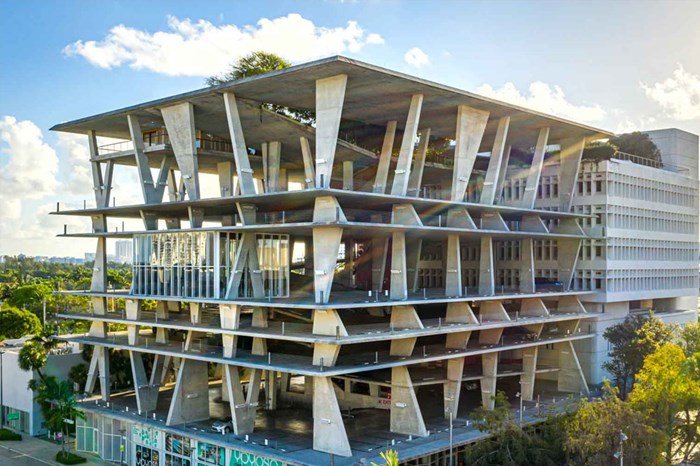
You may be surprised to find that not one, but two of the iconic buildings on this list are actually parking lots. But not just regular parking lots. For example, the parking lot at 1111 Lincoln Road is also a multipurpose building and one of the most iconic architectural markers of South Beach, where locals love to have parties and do weekend yoga with incredible views.
Designed by famed Swiss architects Herzog & de Meuron (the same architects behind the Perez Art Museum Miami, the Tate Modern Museum in London, and countless other institutions around the world), this delightful concept property combines parking, office, and retail under one roof, and packs the experience with fun, innovative design and exciting social events.
The Bass Museum
2100 Collins Ave, South Beach
Built in: 1930s
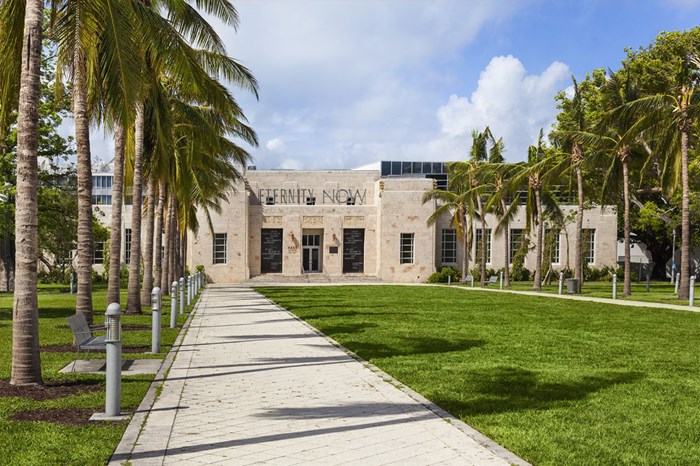
The Bass is one of Miami’s foremost art museums, as well as an architectural treasure of the Art Deco period, although the museum’s interior has been updated and expanded in recent years to reflect the contemporary aesthetic of Miami. The Bass Museum opened in 1964 in what was formerly the Miami Beach Public Library and Art Center, a 1930s Art Deco building designed by Russell Pancoast, grandson of Miami Beach pioneer John Collins.
Set on a beautiful square park, The Bass has an unmistakable Art Deco facade. Founded by Austrian Jewish immigrants John Bass and Johanna Redlich, the museum is the couple’s repository of more than 500 works, ranging from Old Master paintings to Baroque textiles, sculptures, and other historical artifacts, while also focusing on contemporary art acquisitions and exhibitions.
The Bass art collection was donated to the City of Miami Beach with the stipulation that the Museum would remain open to the public in perpetuity. Today the Museum has been through a major renovation but still retains its original Art Deco charm as an icon of South Beach.
The Carlyle
1250 Ocean Dr., South Beach
Built in: 1939
Once the place to “see and be seen” – and an icon of Art Deco design by the late German architect Richard Kiehnel – the Carlyle is now a residential condo hotel community facing the Atlantic Ocean in the heart of South Beach. Another historic icon, the Carlyle opened in 1939, and soon became the most popular hotel destination in Miami Beach, and amplifying its fame thanks to its many appearances in a number of films and television shows, including the famous opening sequence of Miami Vice.
Villa Casa Casuarina formerly The Versace Mansion
1116 Ocean Dr., South Beach
Built in: 1930
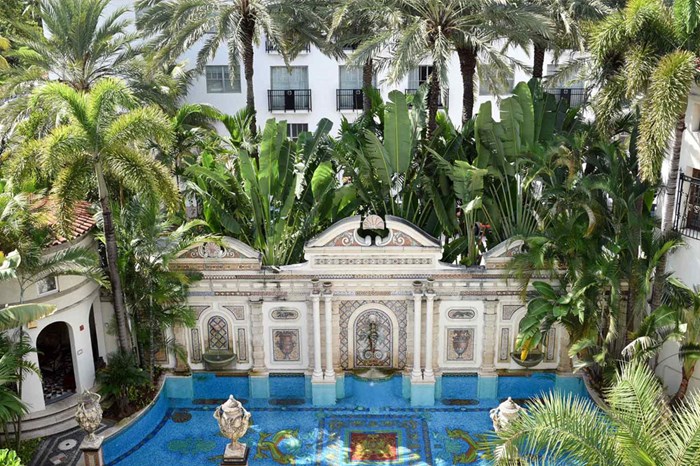
Villa Casa Casuarina, now a hotel, was once the infamous Versace Mansion, owned by Gianni Versace, and the site of his murder that shocked the world, and once a quiet South Beach. Built in 1930 by Alden Freeman, the son of wealthy oil magnate, Alden was enamored with Spanish Colonial architecture and built the original structure to include a main apartment plus two dozed others, where his family and friends could come visit to create a bohemian lifestyle.
After years of passing hands, being an apartment complex, and going into disrepair, Gianni Versace saw the building while on vacation and fell instantly in love. He purchased the building and a since-demolished next-door hotel, and spent tens of millions of dollars to renovate it, add the famous grotto pool and courtyard. The splendor of the building and the design touches of Versace can still be seen today, as you can now dine in the restaurant and stay in hotel.
The Fontainebleau Hotel
4441 Collins Ave., Miami Beach
Built in: 1954
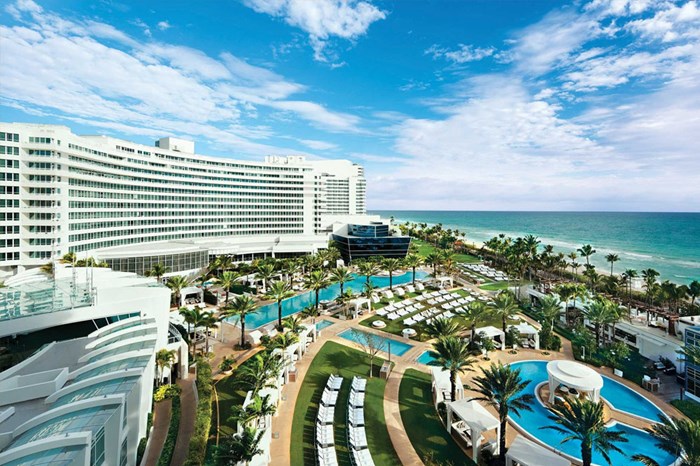
The ultimate symbol of Miami’s mid-century glitz and glamour, the Fontainebleau reigned as the ultimate dream Miami destination throughout the 1950s and 60s after its construction in 1954. Listed on the National Register of Historic Places, the Fontainebleau was sesigned by Morris Lapidus, a Ukrainian immigrant who also designed the Lincoln Road mall, and several other important buildings in Miami. Featuring an extremely modern curvilinear design for the time, the Fontainebleau opened as South Florida’s biggest and most luxurious hotel, in the heart of the famed Millionaire Row in Mid-Beach on 22 acres of beachfront property and a massive curvilinear pool.
In addition to its spectacular 17,000-square-foot lobby, the hotel is known for its legendary “Stairway to Nowhere,” which has made appearances in a number of classic Hollywood films, including James Bond Goldfinger, a special Frank Sinatra show featuring Elvis, Jerry Lewis’ The Bellboy, Scarface, and episodes of The Sopranos, to name a few. The Fontainebleau has hosted celebrities such as Lucille Ball, Judy Garland, Bob Hope, Frank Sinatra, Elvis Presley, and many others, and remains a popular luxury destination today, with highly rated restaurants.
The Standard Hotel
40 Island Ave, South Beach
Built in: 1953
Built in 1953, the Standard Hotel & Spa, located in the beautiful Venetian Islands in South Beach, was originally known as the Monterrey Motel. Designed by architect Norman Giller, the mid-century design was considered groundbreaking in its day. In the 1960s, the motel was expanded and became the Lido Spa Hotel, hosting the hippest visitors to the area. The Standard took over the Lido in 2004 and reopened it in 2006. Catching a sunset during Happy Hour at the Standard is still a favorite Miami pastime to this day, and it still retains its mid-century modern roots.
New World Center
500 17th St, South Beach
Built in: 2010
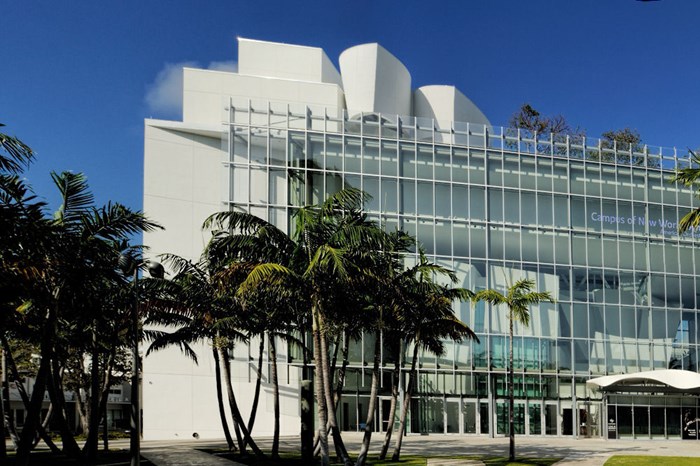
The New World Center, a concert hall in South Beach and home of the New World Symphony, Florida’s first commission of work by famed Pritzker Prize-winning architect, Frank Gehry. With a seating capacity of 756, the postmodern New World Center was opened in January 2011 as America’s Orchestral Academy (NWS), and prepares graduates of music programs for leadership roles in professional orchestras and ensembles.
With it’s sublime white facade and post-modern design elements, the New World Center has become a beloved part of Miami Beach, and for part of the year, features a giant screen on its façade onto which films and concerts are projected for public view, for outdoor movie nights and concerts.
Iconic Buildings in Miami
The Freedom Tower
600 Biscayne Blvd., Downtown Miami
Built in: 1925
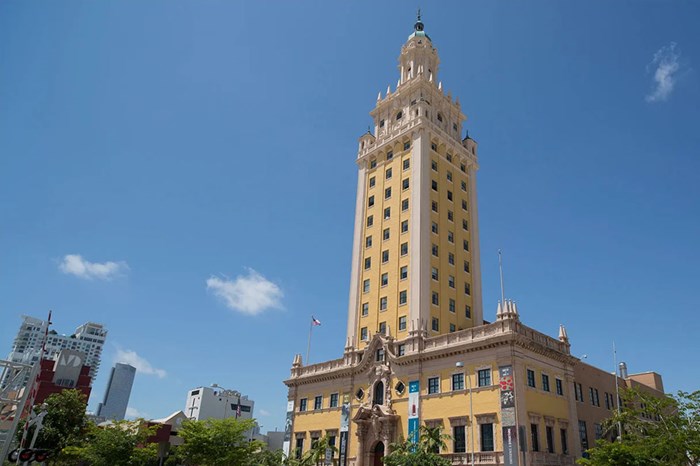
Photo courtesy of Miami and Beaches
Perhaps Miami’s most iconic structure, the Freedom Tower earned its name thanks to its rich history as the site of the processing of thousands of Cuban immigrants who migrated to Miami in the 1960s, and stands as a symbol of Miami’s diverse population of immigrants from all over the Americas. The 17-story Mediterranean-style building, completed in 1925 and designed by Schultze and Weaver, is located in Downtown Miami, and painted a nostalgic yellow.
The Tower is lit up in various colors at night so that it is always visible in the Downtown Miami skyline. Today, the building houses Miami Dade College's Museum of Art + Design (MOAD), as well as administrative offices for the Miami International Film Festival.
1000 Museum
1000 Biscayne Boulevard, Downtown Miami
Built in: 2019
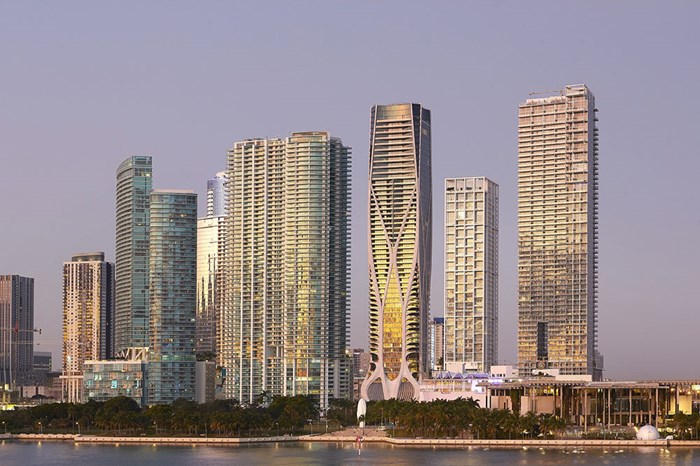
Photo courtesy of Zaha Hadid Architects
One of Miami’s newest claims to fame, One Thousand Museum is a stunningly unique, luxury condominium tower located in Downtown Miami, designed by the late Pritzker Prize-winning architect Zaha Hadid. Hadid, known as one of the world’s most cutting-edge architects, passed away before the completion of this project, making this the last condominium tower project that she designed in her lifetime.
The building, which is also known as the Scorpion Tower for its exoskeleton, celebrates the essence of Miami through the eyes of this famed and beloved British/Iraqi architect. Its just as stunning landscape is the work of Enzo Enea, one of Miami's most renowned landscape design architects. It’s currently home to several celebrities, including Victoria and David Beckham.
Adrienne Arsht Center for the Performing Arts
1300 Biscayne Blvd., Downtown Miami
Built in: 2006
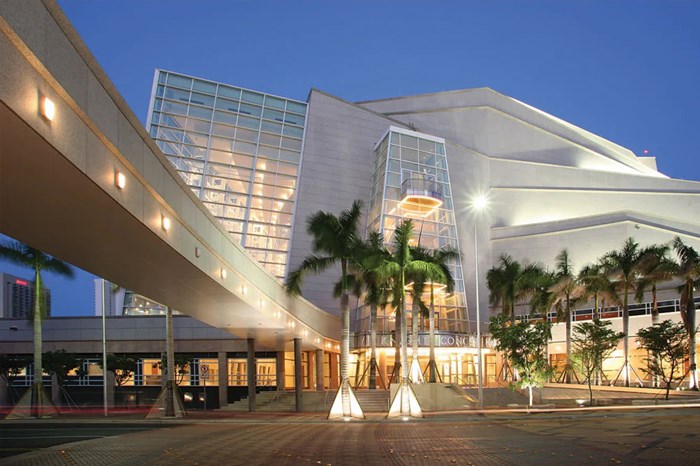
Photo courtesy of Miami and Beaches
Miami’s premiere performing arts center is one of the largest of its kind in the United States. Designed by Cesar Pelli, the Arsht Center sits partly on the site of a former Sears department store that was built in 1929 in Downtown Miami as a prime example of Art Deco architecture, pre-dating the Art Deco district on Ocean Drive.
Made up of three buildings, including the Ziff Ballet Opera House, modeled after the classic opera houses of Europe with 2,400 seats, the John S. and James L. Knight Concert Hall, seating 2,200, and the Carnival Studio Theater with 250 seats. In total, the Arsht Center occupies two 570,000 square feet buildings that are connected by a pedestrian bridge bestriding Biscayne Boulevard, and is one of the most dramatic silhouettes in the Miami city skyline.
Miami-Dade County Courthouse
73 W Flagler St., Downtown Miami
Built in: Originally built in 1904; replaced in part in 1925
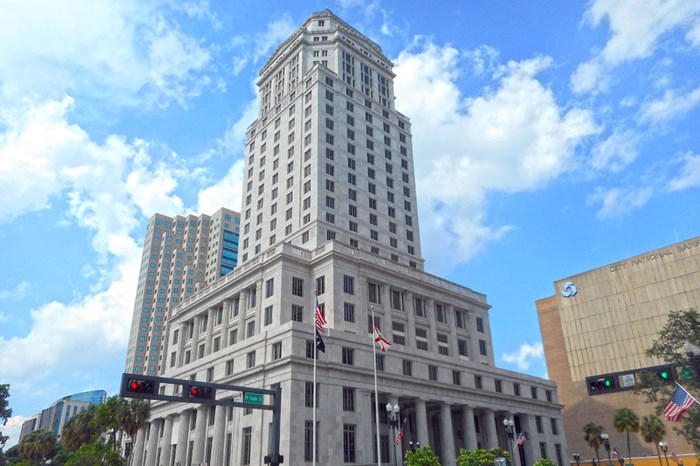
The historic Miami-Dade Courthouse, located in the heart of Downtown Miami, was built in 1904, and made history as the tallest building in all of Dade County at the time. In fact, it was actually the tallest building anywhere south of Baltimore! The building was replaced in 1925 with a larger, 27-story structure in the same location to accommodate Miami's growing population, designed by Atlanta-based architect A. Ten Eyck Brown, who was known for designing many courthouses across the South.
The courthouse was also the home of the City Jail until 1961. Currently, the building still serves as the primary civil courthouse for Miami-Dade County. The building was added to the National Historic Register in 1989.
Miami River Inn
118 SW South River Dr., Miami River
Built in: 1908
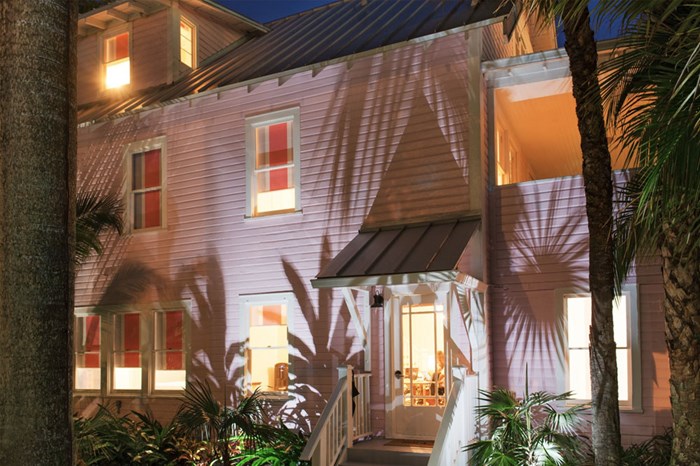
Miami’s oldest hotel was originally erected as a Victorian boarding house in 1908, and consisted of a group of pastel-colored wood-frame houses adjacent to the Miami River. Located in one of the oldest neighborhoods in Miami, on the edge of what is now Little Havana, the original structures are still standing and have been recently restored. Today, the River Inn Miami hotel is operated by ROAM, and is also home to an eatery called Casa Florida.
The four wood Vernacular-style structures were entered into the National Register of Historic Places in 1987.
Miami Tower
Knight Center Metromover Station, Downtown Miami
Built in: 1987
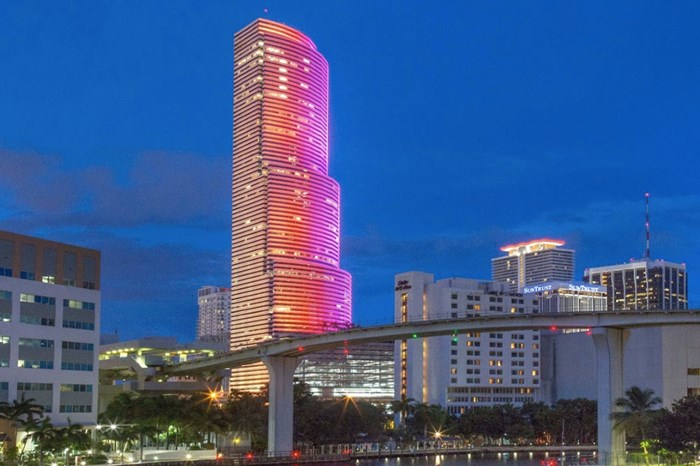
The Miami Tower is one of Miami’s oldest skyscrapers, and an iconic feature of the Downtown Miami skyline. At a height of 625 feet, the 47-story office tower is currently the 16th tallest building in Miami and all of Florida. Designed by Pei Cobb Freed & Partners (of famed international architect I.M. Pei), the structure consists of a 10-story parking garage as well as the 47-story office tower.
The Miami Tower is beloved by local residents as a beacon in the skyline that is illuminated at night in different colors to celebrate different themes. Built in 1987, the Miami Tower was included in the AIA Florida Chapter’s publication, Florida Architecture: 100 Years.
Miami Women’s Club
1737 N Bayshore Dr, Edgewater
Built in: 1926
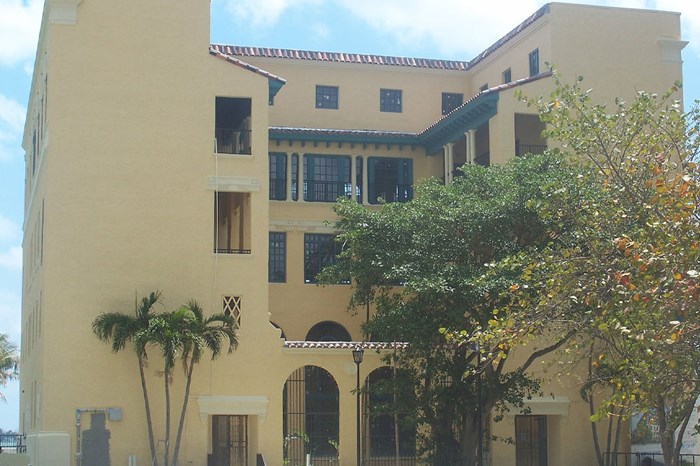
The Miami Women's Club is a historic site in the residential neighborhood of Edgewater, designed by August Geiger and built in 1926. Added to the U.S. National Register of Historic Places in 1974, the Mediterranean Revival style building is designed in a U shape that encompasses a central courtyard, and features massive arched windows overlooking the waters of Biscayne Bay. In recent years, the building has undergone several renovation, and in the last year, a luxurious restaurant and bar, Klaw, was opened on its rooftop, with more planned for the historic waterfront building.
The Moore Building
191 NE 40th St., Design District
Built in: 1921
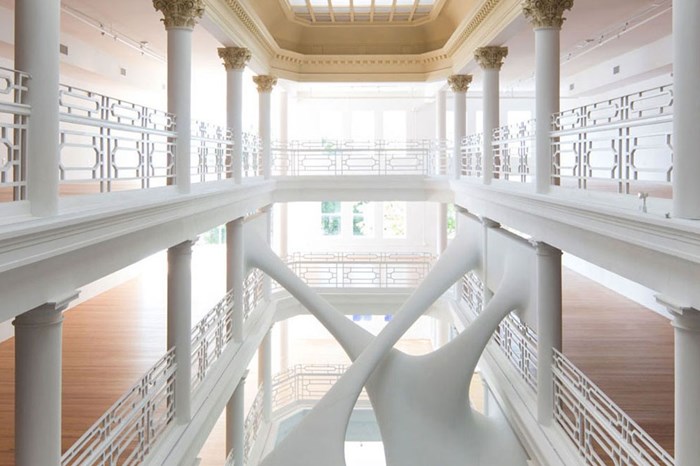
The Moore Elastika Building is a beautiful and pristinely preserved Art Deco structure originally built in 1921 as a furniture showroom for Moore and Sons. The building is now used as an art and design event venue, and is the most historic venue in Miami’s Design District.
Among its features, the building has a 4-story atrium that accommodates 2,000 people for receptions and 1,000 for seated events and features a permanent, site-specific installation titled "Elastika," created by iconic architect and artist Zaha Hadid. The Moore Building is definitely a current a favorite “see and be seen” location among Miami’s art crowd and hosts some of most elite parties during the annual Art Basel and Miami Art Week.
Museum Garage
90 NE 41st St., Design District
Built in: 2016
Photo courtesy of Miami Design District
The Museum Garage is another iconic structure, and happens to be another parking lot in the Design District. Commissioned in 2015 by developer Craig Robins, the building façade was designed by WORKac, J. Mayer H., Clavel Arquitectos, and Nicolas Buffe while K/R (Keenen/ Riley), and Tim Haahs designed the structure.
These designers from around the world, brought together by the late architectural and art curator and museum director Terence Riley, drew inspiration from the surrealist parlor game known as “Exquisite Corpse,” which involves creating drawings among various artists without any artist knowing what the other artists have drawn, producing whimsical and playful compositions. The building, created in this manner, embodies the spirit of the Exquisite Corpse and is an architectural work of art.
Olympia Theater at the Gusman Center
174 E Flagler St., Downtown Miami
Built in: 1925
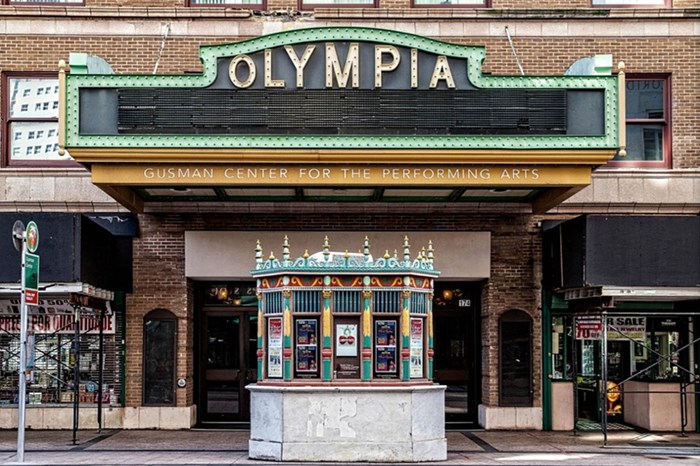
Photo courtesy of Olympia Arts Miami
The Olympia Theater, one of Miami’s oldest theaters set in Downtown Miami, was designed by John Eberson and showcased Moorish architecture and his atmospheric style. Opened in 1926, it has served as a movie theater and performing arts venue ever since.
Originally designed to accommodate vaudeville and other performance arts, the theater was built by Paramount, so it always also had a connection to the film industry, with the Marx Brothers, burlesque star Gypsy Rose Lee, Elvis, Pavarotti, Etta James, B.B. King, Johnny Cash, The Police, and many other stars performing here. After renovations in the 1970s by Morris Lapidus, today, it still presents specialty film screenings and premieres, and serves as a venue for the Miami International Film Festival yearly. It was added to the National Register of Historic Places in 1984.
Pérez Art Museum Miami (PAMM)
1103 Biscayne Blvd, Downtown Miami
Built in: 2013
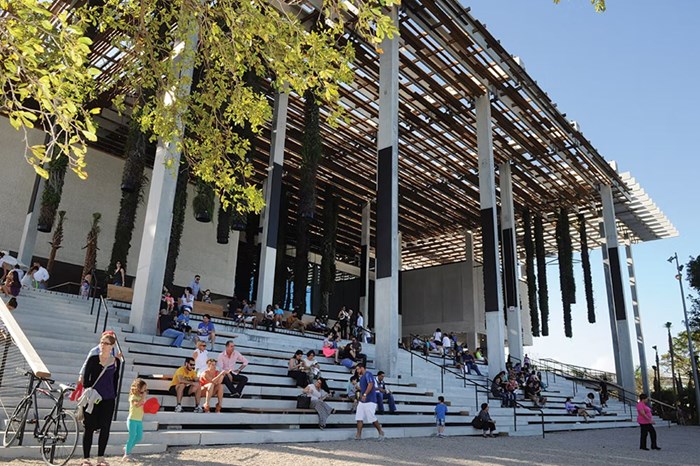
Photo courtesy of PAMM
Designed by renowned Swiss architects Herzog and de Meuron, the airy structure of the museum is inspired by Stiltsville, a community of wooden houses built on stilts located in Biscayne Bay, just off the coast of Key Biscayne. The building, completed in 2013, is LEED certified and built with sustainable materials, as well as especially designed to take advantage of the cool breezed blowing off the Bay as well as to survive hurricanes.
The best international architects thought of everything, so the expansive deck area features a series of vertical hanging gardens that showcase native vegetation, designed by French botanist Patrick Blanc. It’s truly a one-of-a-kind structure, that also houses one of the best contemporary art collections in the world. Have lunch or dinner on its back terraces at Verde.
The Biltmore Hotel
1200 Anastasia Ave, Coral Gables
Built in: 1926
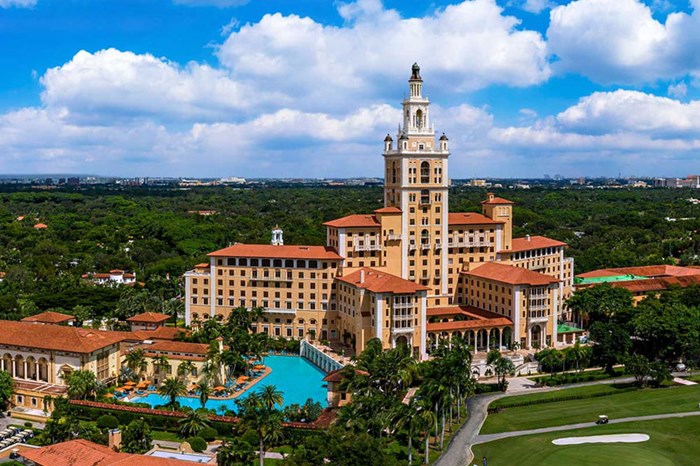
Photo courtesy of The Biltmore Hotel
Built in 1926, the Biltmore was designed by two of the most renowned Miami architects, Schultze and Weaver, who also designed the famed Freedom Tower as well as a great deal of buildings across the U.S. and Cuba. This glamorous Coral Gables hotel is not only an iconic structure representing the Mediterranean architectural style of the 1920’s, it also has a colorful history as one of Miami’s most idiosyncratic settings.
Visited by a host of celebrities and luminaries, including European royalty as well as President Franklin D. Roosevelt, the hotel was also frequented by gangsters and was the site of the murder of Thomas "Fatty" Walsh. The Biltmore was then temporarily repurposed as a military hospital during World War II. Today, it is a popular South Florida destination, and offers “ghost-tours” that delve into the spookier side of its iconic history, as well as a favorite golf course.
The Tower Theater
1508 SW 8th St, Calle Ocho
Built in: 1926
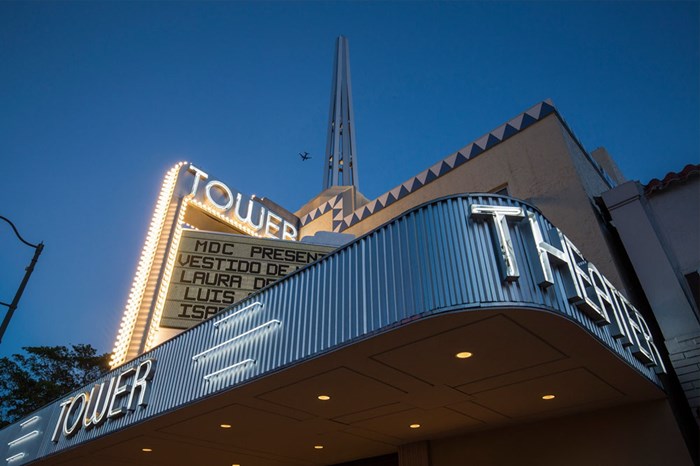
Built in 1926, the Tower Theater was one of the first and most luxurious theaters in the South during its heyday, and remains one of Miami's oldest cultural landmarks. During the Cuban influx into Miami in the 1960s, the theater, located in the heart of Little Havana, began presenting English-language films with Spanish subtitles, and eventually Spanish-language films, as well as indie and foreign films. The theater is still active today as an important community venue and art cinema.
William Wagner House
Lummus Park, 404 NW 3rd St., Downtown Miami
Built in: 1850s
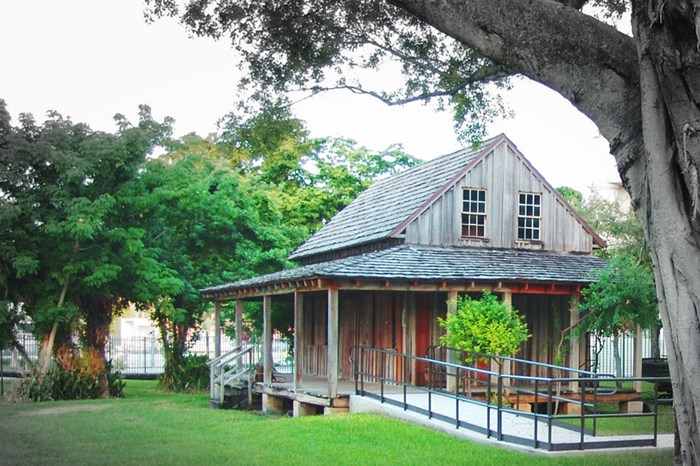
Photo courtesy of Hidden History Miami
The William Wagner house is the oldest home standing in Miami-Dade County, and is said to have been built around the mid-1850s, during Miami's homesteading era. Wagner was a local political figure, and also helped to establish the city's first Catholic church in 1875. The Wagner house was originally built near a tributary of the Miami River and exemplifies the Balloon frame architecture characteristic of the early days of settlement along the Miami River. In 1979, the Dade Heritage Trust relocated the house to Lummus Park in Downtown Miami, and the house remains the only known antebellum era house in all of Miami.
Vizcaya Museum & Gardens
3251 S Miami Ave., Coconut Grove
Built in: 1910
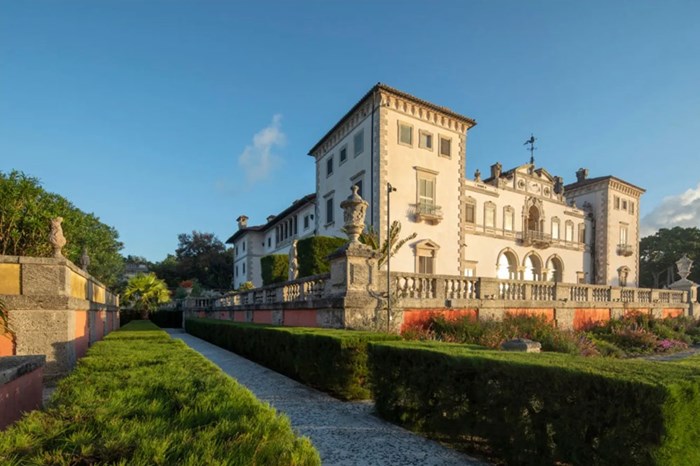
Photo courtesy of Miami and Beaches
The Vizcaya Museum and Gardens, built in 1910 in the Mediterranean Revival style with a touch of Baroque elements, was formerly known as Villa Vizcaya, and was the villa and estate of prominent businessman James Deering, an early conservationist. The magnificent property sits upon a mangrove forest along Biscayne Bay in what is now Coconut Grove.
The over-the-top estate includes an extensive art collection, and pristinely manicured Italian Renaissance gardens complete with an array of garden sculptures and grottos. Inspired by Veneto and Tuscan Italian Renaissance architecture and gardens, Vizcaya was designed by architect F. Burrall Hoffman, designer Paul Chalfin, and landscape architect Diego Suarez.
Much of Miami’s architectural beauty lies in its playful combination of old, historical, and new architectural elements, with buildings that define the Miami lifestyle, dating from the 19th to the 21st Centuries. There are many incredible buildings in Miami to visit and explore. Let us know your favorites, or if we missed any that you’d want covered in the future!
Share your thoughts with us
Your Miami Condo Awaits
Recent Posts





